Share this
Microsampling: Antarctica Explorers Track Impact of Climate on Humans
by Neoteryx Microsampling on February 20,2023
It was nearly one year ago that intrepid British explorers Justin Packshaw and Jamie Facer-Childs completed a 2,000 km kite-ski expedition across Antarctica – a journey that involved collecting biological microsamples and gathering data to help scientists monitor the impacts of extreme conditions on human physiology and psychology.
The biological samples and data gathered by the two explorers are now being analyzed by researchers at NASA, the European Space Agency (ESA), the Snyder Lab at Stanford Medicine (Stanford University), and the University of Central Florida (UCF) to increase our understanding of how the human body and mind respond to challenging environments and changing climates.
Packshaw and Facer-Childs also took measurements of changes they discovered on the Antarctic ice shelf and provided reports on those changes to complement ESA’s CryoSat data on how the giant ice sheet is responding to climate change.
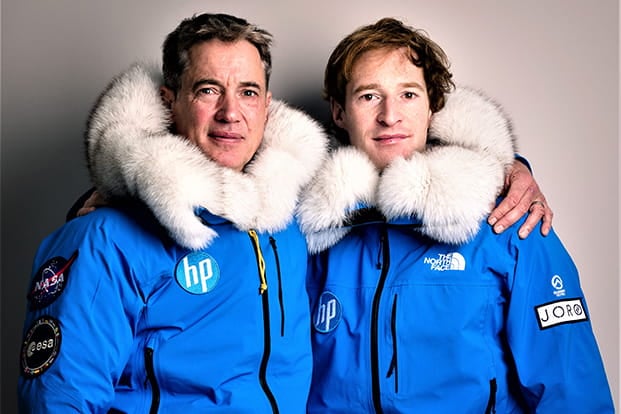 Packshaw and Facer-Childs covered the nearly 2,000 kilometres of icy tundra in roughly 60 days, while man-hauling the equipment and goods needed for both their research contributions and their survival.
Packshaw and Facer-Childs covered the nearly 2,000 kilometres of icy tundra in roughly 60 days, while man-hauling the equipment and goods needed for both their research contributions and their survival.
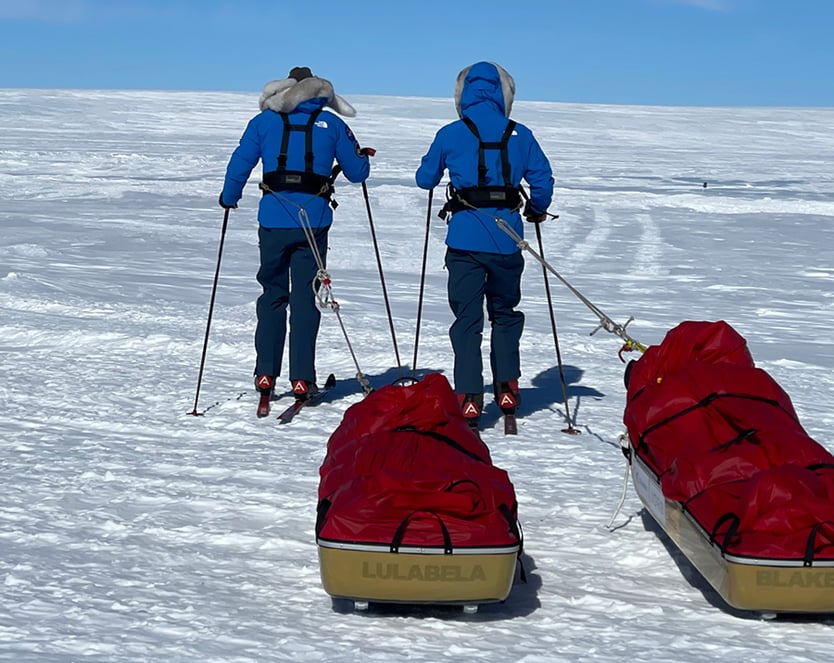
At stopping points along the journey, they pitched their tents and, once inside, they self-collected bio-fluid samples (i.e., blood, urine, saliva, etc.) and recorded their experiences. In addition to collecting bio-samples they also provided wellness reports via video chat and digital messaging for the research and space exploration teams.
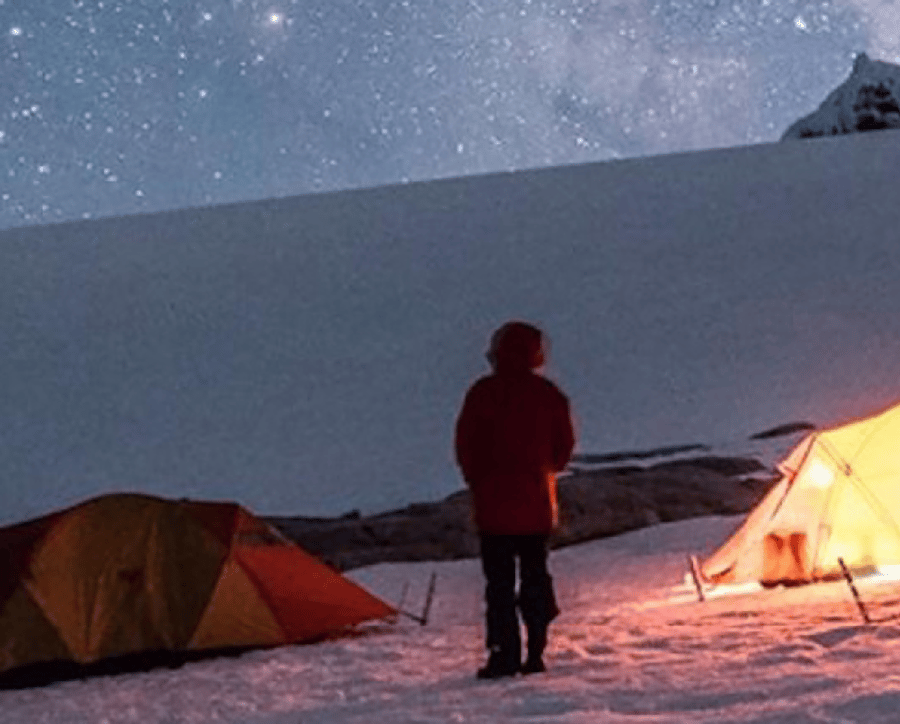
According to expedition reports and articles posted on their "Chasing the Light" Expedition website, the explorers were subjected to 150 km/hr winds, –55° C temperatures and whiteouts that hindered their progress, leading to some lost days and the need to hole-up in their tents and modify their route. They made the journey unsupported by mechanical, human or animal assistance, relying solely on their training, physical stamina and mental strength, which makes their achievements that much more remarkable.
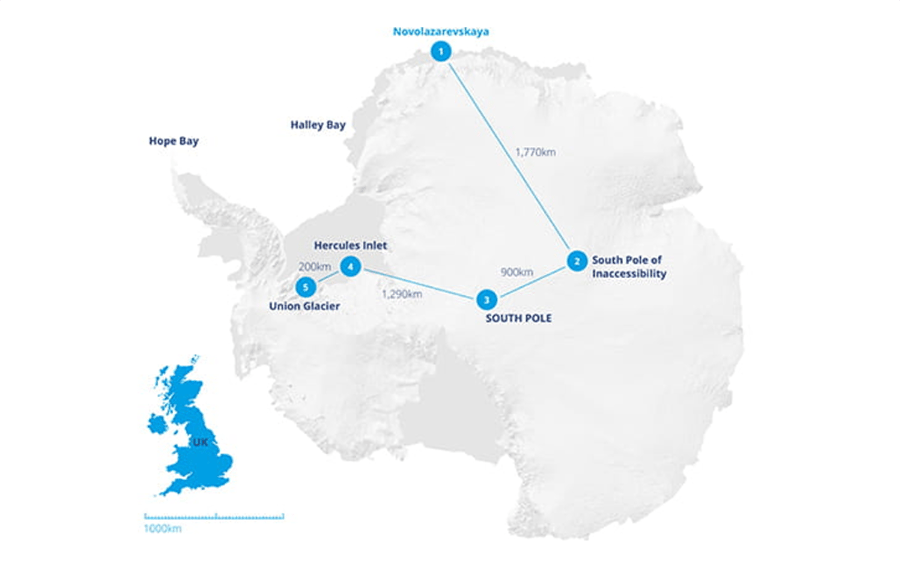
Image: CryoSat; Collinson Group: Mapped Route of the Antarctica "Chasing the Light" Expedition
To help the researchers better understand the limits of the human body from a multiomics perspective, the explorers were equipped with cutting-edge technologies like wearables and portable sampling devices.
The data from the samples enabled the scientists to monitor physiological changes and effects before, during and after the explorers’ kite-ski expedition in the most extreme environment on earth. NASA hopes to use the data to understand whether humans could survive on Mars.
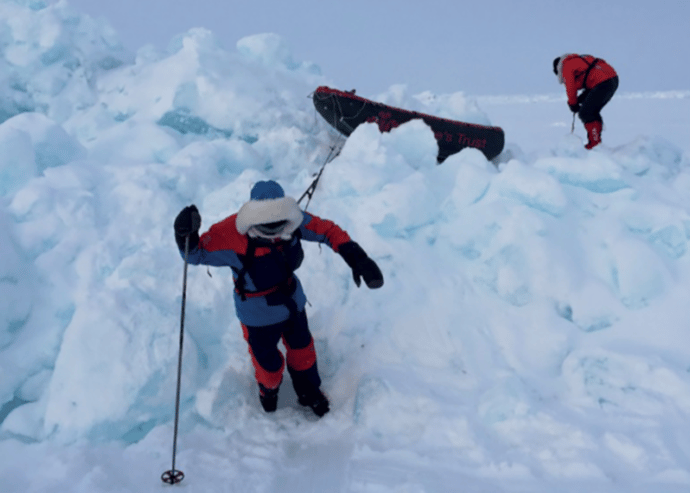
Blood Microsampling with Mitra Devices for Multiomics Research
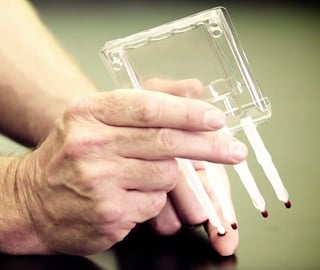 Packshaw and Facer-Childs used Mitra® devices with VAMS® technology from the Neoteryx range of microsampling products at Trajan Scientific and Medical to self-collect blood microsamples at different time points. The miniature Mitra microsampling devices are light, portable, and designed for easy finger-stick sampling by anyone, anywhere – including explorers collecting samples inside a tent buffeted by high winds at the South Pole!
Packshaw and Facer-Childs used Mitra® devices with VAMS® technology from the Neoteryx range of microsampling products at Trajan Scientific and Medical to self-collect blood microsamples at different time points. The miniature Mitra microsampling devices are light, portable, and designed for easy finger-stick sampling by anyone, anywhere – including explorers collecting samples inside a tent buffeted by high winds at the South Pole!
According to scientists in the Snyder Lab at Stanford Medicine, standard blood collection approaches didn't meet their needs for portability, flexibility, and minimally invasive sampling methods.
The Mitra devices were chosen because they enable researchers to conduct comprehensive longitudinal profiling independent of access to a blood draw lab or clinic.
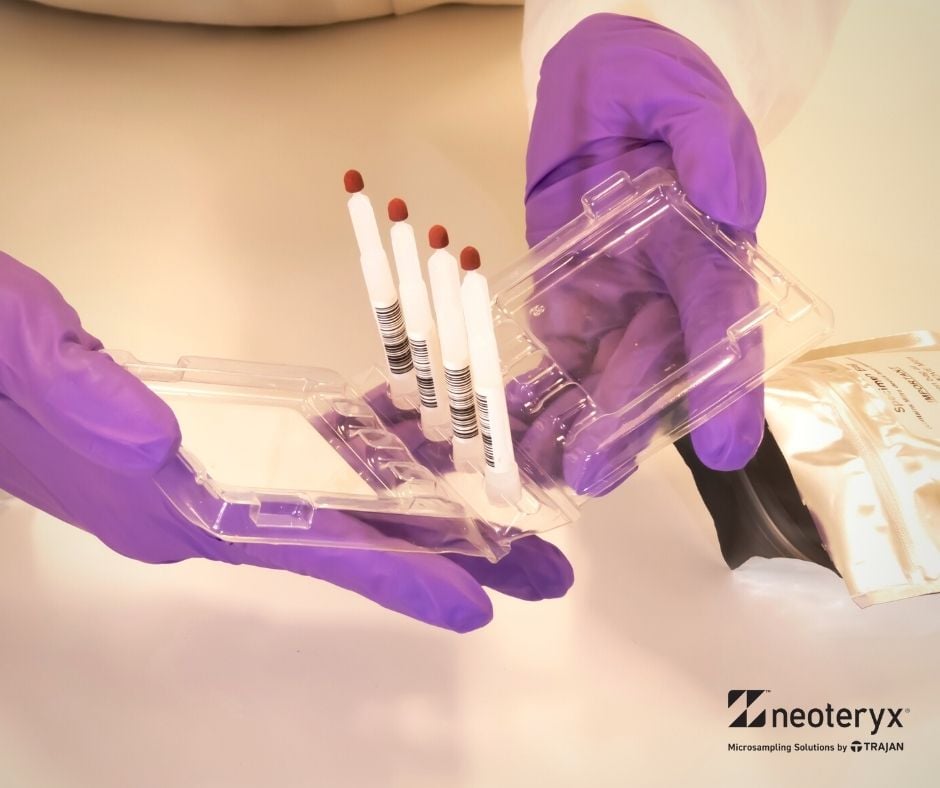
Further, many molecules from the Mitra microsamples have been proven to remain stable, delivering reliable data consistent with those derived through conventional blood sampling approaches.
After blood samples were collected, the explorers sealed them inside specimen bags that contained drying desiccant to ensure the samples remained dry and stable in their packs during the journey.
Once samples arrived in the lab, they were processed and analyzed following a dried blood sample (DBS) workflow.
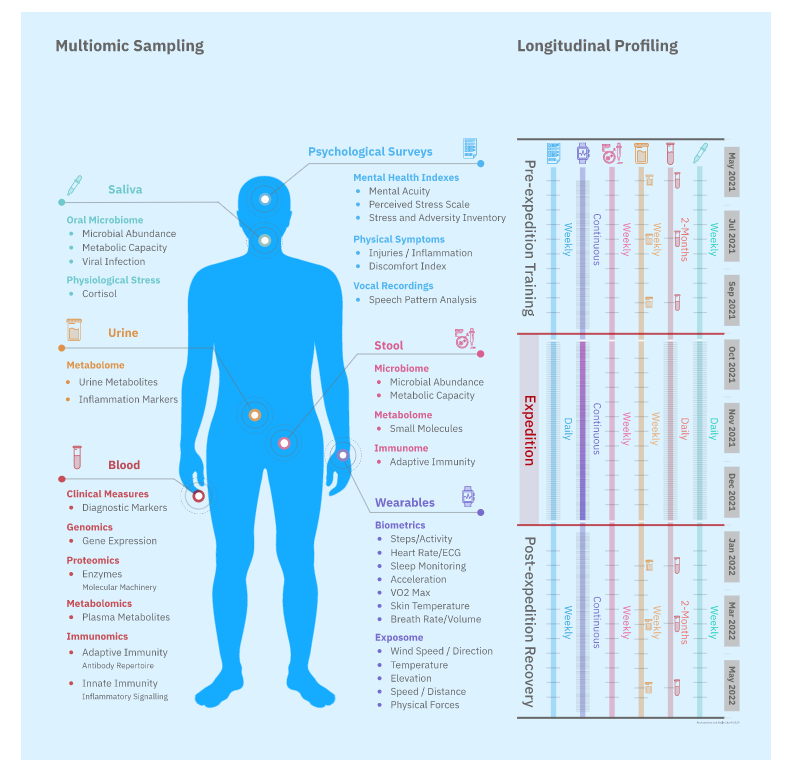
Image: Stanford Medicine, Snyder Lab: Biological Sampling for Multiomics Research
The researchers correlated all the human data from the bio-samples collected before, during and after the explorers’ kite-ski expedition. The preliminary data was posted on the Snyder Lab, Stanford Medicine website in December 2022, and will no doubt be discussed in future publications.
Expedition updates posted by Justin Packshaw along their arduous journey illustrate the difficulty of their endeavor but also the pride they felt in contributing to science through this unique study. An excerpt from Packshaw's final report is included below:
Justin Packshaw's Final Update, Posted via The Expedition Website
(09/01/22): "We are still reeling from the fact that our goal has been obtained and we can relax and do not have to steel ourselves to the brutality of having to operate in this harsh land, to be honest. I cannot lie, in that hard graft and grit have been our constant companions but equally it has been so rewarding working as a tight, efficient team throughout and the fact that we have done it as sustainably as possible.
We have done so much research along the way for NASA, ESA, Stanford University and UCFL around Climate Change, and our physiology and psychology, which has been fascinating. The results are going to be super interesting and hopefully will make a difference and help somewhere along the line. Adventure is such a brilliant thing to step into, whatever it might be, little or big, challenging or not, physical or mental, the outcome will always have you growing, learning and walking a tad taller. Ours certainly has..."
– Justin Packshaw
This is curated content. To learn more about the important research outlined in this blog, please visit the websites for the Snyder Lab at Stanford Medicine, NASA, the European Space Agency (ESA) and the "Chasing the Light" expedition website.
Image Credits: CPOM, CryoSat, ESA, NASA, Chasing the Light, Stanford, Neoteryx, Trajan

For more information on how Neoteryx microsampling products from Trajan help researchers gather data, please visit our Technical Resource Library featuring peer-reviewed study papers and other resources.
Share this
- Microsampling (41)
- Industry News, Microsampling News (35)
- Mitra® Device (34)
- Company Press Release, Product Press Release (22)
- Research, Remote Research (18)
- Infectious Disease, Vaccines, COVID-19 (15)
- Clinical Trials, Clinical Research (14)
- Biomonitoring, Health, Wellness (10)
- Blood Microsampling, Serology (10)
- Decentralized Clinical Trial (DCT) (8)
- Omics, Multi-Omics (7)
- Venipuncture Alternative (6)
- Skin Microsampling, Microbiopsy (5)
- Harpera Device (3)
- Specimen Collection (3)
- Toxicology, Doping, Drug/Alcohol Monitoring, PEth (3)
- Pharmaceuticals, Drug Development (2)
- Therapeutic Drug Monitoring, TDM (2)
- Antibodies, MAbs (1)
- Environmental Toxins, Exposures (1)
- Preclinical Research, Animal Studies (1)
- hemaPEN® Device (1)
- December 2025 (1)
- May 2025 (1)
- April 2025 (1)
- February 2025 (4)
- September 2024 (1)
- August 2024 (1)
- May 2024 (2)
- January 2024 (1)
- December 2023 (2)
- November 2023 (3)
- October 2023 (2)
- September 2023 (1)
- August 2023 (3)
- July 2023 (3)
- June 2023 (1)
- May 2023 (2)
- April 2023 (1)
- March 2023 (2)
- February 2023 (1)
- January 2023 (2)
- December 2022 (1)
- November 2022 (1)
- October 2022 (2)
- August 2022 (1)
- April 2022 (1)
- February 2022 (1)
- January 2022 (1)
- December 2021 (1)
- November 2021 (1)
- October 2021 (2)
- September 2021 (1)
- August 2021 (2)
- July 2021 (2)
- June 2021 (2)
- April 2021 (1)
- March 2021 (2)
- February 2021 (1)
- January 2021 (1)
- December 2020 (1)
- November 2020 (1)
- October 2020 (1)
- September 2020 (2)
- August 2020 (3)
- July 2020 (3)
- June 2020 (2)
- May 2020 (1)
- April 2020 (3)
- October 2019 (1)
- March 2019 (1)
- January 2019 (1)
- November 2018 (1)
- August 2018 (1)
- July 2018 (1)
- June 2017 (1)
- April 2017 (1)
- March 2017 (1)
- February 2017 (1)
- May 2016 (1)
- December 2015 (1)
- October 2015 (1)
- August 2015 (1)
- August 2014 (1)
- July 2014 (1)

No Comments Yet
Let us know what you think